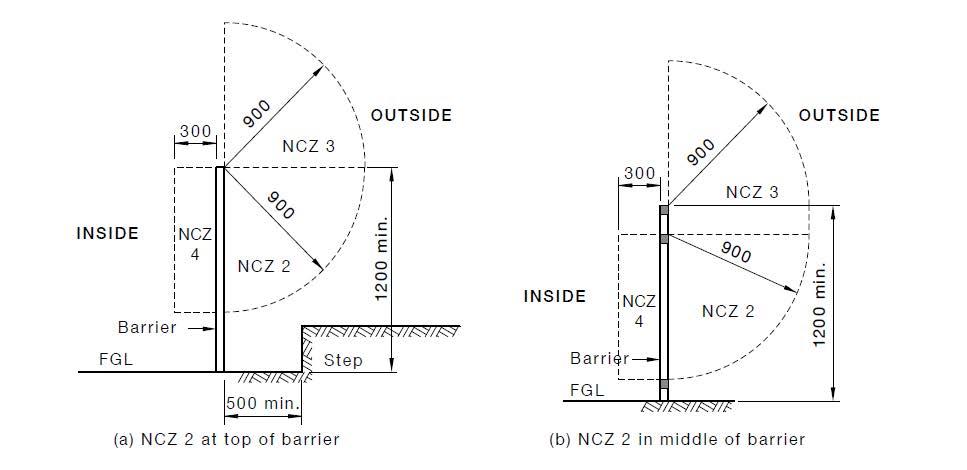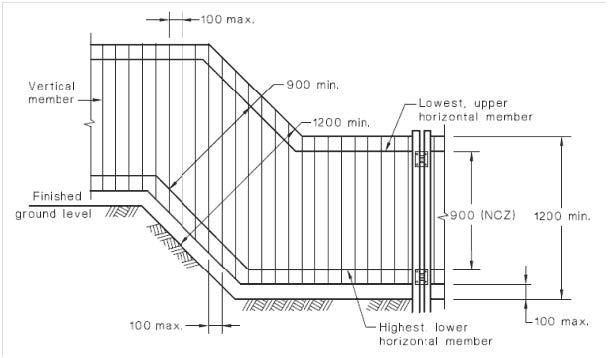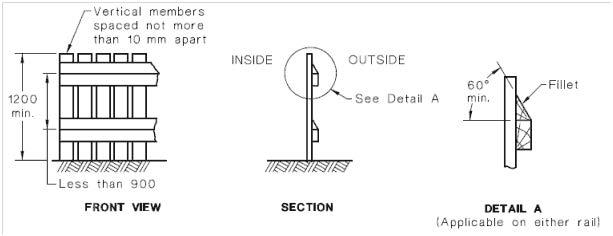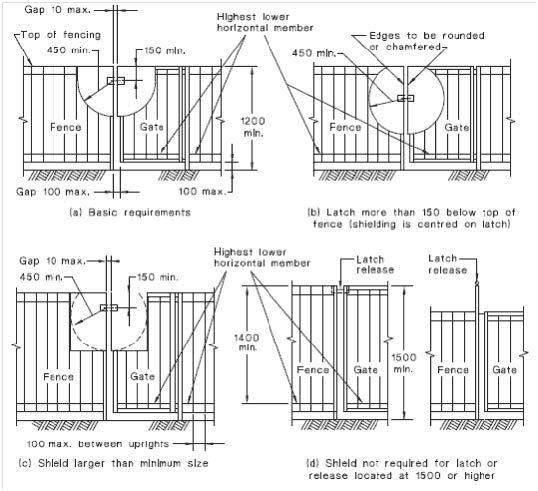The current Australian Standard AS1926-2012 (the standard) is in place as the standard in NSW, VIC, SA, TAS, WA and the ACT. In these jurisdictions, the standard is called up buy the Building Code of Australia (BCA) and in many cases, there are local variations affected under legislation. Northern Territory operates under AS1926.1-1993.
Queensland has is own standard in place which is a modified version of AS 19326-2007 combined with a state standard QDC MP 3.4
All jurisdictions other than Queensland have in place multiple standards in the sense that as new standard have been adopted existing pools conforming to the then current standard have been allowed to maintain conformity with that standard. Pool owners may continue to comply with the standard that the pool was constructed. under on the provision that there have not been any substantial changes to the barrier. If substantial changed have nee made then the pool owner is required to comply with the most up to date Standard.
Exemptions from the standard
There are two categories of exemptions to the national standard:
Those that are effected through the BCA as a variation to the standard as it applies in a particular jurisdiction
Legislative exemptions to the application of the legislation
In NSW, there are two cases of the first category of variation:
NSW spas are proved with an alternative to pool fencing and may have a lockable lid that is capable of being operated by one person and must be locked when the spa is not in use.
NSW does not permit an out of ground wall of a pool to be used as a pool barrier
These NSW variations do not apply in other jurisdictions where fencing is required for spa pools, and out of ground wall of a pool can be used as a barrier if they meet the requirements of the standard.
There are also exemptions applying to particular types of properties with pools in a number of jurisdictions. These apply in NSW (historic exemptions for small, large and waterfront properties), Tasmania )pools built before 1 November 1994), the ACT (pools built before 1970) and the Northern Territory (pools built prior to 1 January 2003 and pools on small and large properties)
Local council have the power in NSW, QLD and WA to approve alternate barriers that can be demonstrated to provide the same safety as an AS1926.1 barrier.
Australian Standard AS1926.1-2012 Version
Pool Fence - Height
Australian standard AS 1926.1-2012 stipulates that a pool fence shall be not less than 1.2m high all the way around.
Note: If the pool barrier is not 1.2m high all the way around or only in some sections then the home owner should seek immediate advice from a Licensed Builder, Pool Technician or Fencing Contractor.
Pool Fence - Non Climbable Zone (NCZ)
Australian standard AS 1926.1-2012 stipulates that a fence must have a Non Climbable Zone (NCZ) of 900mm on the outside of the pool fence all the way around.
Note: Trim trees or shrubs near the pool fence and other objects such as BBQ's, pot plants, toys, ladders and chairs should not encroach within the NCZ area.
The following NCZ's shall be present on all barriers with a height less than 1800mm.
NCZ 1 is a 900 mm vertical plane on the outside face of a barrier. Thus NCZ may be located anywhere within the perpendicular height of a barrier or, where present, anywhere between horizontal components or handholds and footholds on a barrier.
NCZ 2 is a quadrant on the outside of a barrier created by a 900 mm radius down from the top of NCZ 1 above.
NCZ 3 is a quadrant on the outside of a barrier created by a 900 mm radius up from the top of the barrier. When the top of NCZ 1 is below the top of a barrier then NCZ 3 shall extend vertically down to the top of NCZ 1 )see figures 2.1 and 2.11) NCZ 3 is applicable only to the space created by the quadrant and does not apply to any item or component on, or that is part of, the barrier.
NCZ 4 is required on all barriers with vertical openings 10-100 mm in width and is a 900 mm high by 300 mm deep rectangular space on the inside of the barrier and shall align with NCZ 1
Note: NCZ 2 is always immediately adjacent to NCZ 1 on all barriers.

Boundary Fence used a part of Pool Fence
Australian Standard 1926.1-2012 stipulates that when a Boundary Fence (min 1.8m) is used as part of the child resistant barrier than the Non Climbable Zone (NCZ) of 900mm will be measured from the inside (pool side) of the fence.
Note: Climbable objects or surfaces should not encroach on the 900mm non climbable zone on he inside of Boundary Fences (1.8m)
If a Horizontal surface is located within the NCZ then a fillet is an acceptable solution which would rectify the problem.
Pool Fence - Veritcal Gaps
Australian Standard AS 1926.1-2012 stipulates that gaps between vertical members of the fence shall not be greater than 100mm
Vertical Gaps in the fence must not be more than 100mm

Note: If the Veritcal gaps in the fence are greater than 100mm all the way around or only in some sections then the home owner should seek immediate advice from a Licensed Builder, Pool Technician or Fencing Contractor.
Pool Fence - Gap at Bottom
Australian Standard AS 1926.1-2012 stipulates that the Gap at the bottom of the fence must be a maximum of 100mm
If the gap at the bottom of the fence is greater than 100mm all the way around or only in some sections then the home owner should seek immediate advice from a Licensed Builder, Pool Technician or fencing Contractor.
Pool Fence - Horizontal Climbable Members
Australian Standard AS 1926.1-2012 stipulates that horizontal members shall not be within the 900 mm Non Climbable Zone (NCZ) (on the outside of the pool fence).
If a pool fence does have horizontal members on the pool fence then they must be non climbable.

Note: If the horizontal; members which form part of the fence are in the Non Climbable Zone (NCZ) all the way around or only in some sections then the home owner should seek immediate advice from a Licensed Builder, Pool Technician or fencing Contractor.
Pool Gates - Self closing & latching devices
Australian standard AS 1926.1-2012 stipulates that gates shall be hung so that they ONLY swing outwards, i.e. away from the pool area. The gate must be able to swing freely through its arc of operation.
All gates must be fitted with a Self-Closing Device that will return the ate to a closed position from any position without the use of manual force.
All gates must be fitted with a Latching Device that will automatically operate on the closing of the gate and prevent that gate from being reopened without being manually released.
Note: A pool gate that is not self closing or does not have a latching device should be permanently secured until such time as the device/s can be installed. Self closing and latching devices can be purchased from most pool shops and hardware shops and are relatively easy to install.
Pool Fence - Latching Device Location
Australian Standard AS 1926.1-2012 stipulates Latching Device Locations, Acceptable basic Latching Device Locations are:
Where a latching device is located less than 1500mm then the following applies:

Note: A pool Gate which has its latching device at the incorrect location can be easily relocated with the use of some very basic tools to the correct location, if in doubt, consumers should be encouraged to see the advice and/or services of a Licensed Builder, Pool Technician or fencing Contractor.
Cardio Pulmonary Resuscitation (CPR) Signage Requirements
Knowing CPR can save lives and can help to reduce serious water related incidents.
CPR signage placed in the pool or spa area is not only a good way to constantly remind you of what to do in the event of an emergency but it is a legislated requirement in many states of Australia.
In January 2016, the Australian Resuscitation Council (ARC) released the Australian and New Zealand Committee on Resuscitation (ANZCOR) Guidelines of cardiopulmonary Resuscitation (CPR). Signage setting out pool safety and CPR is legislated in NSW and Queensland. Whilst not legislated, all other jurisdictions actively observe the ANZCOR guidelines and CPR signs are installed in all pools and spas.
Compliant CPR signs detail the DRSABCD first aid method
D Danger? - Check for danger to yourself, the patient and bystanders
R Response? - Check the patient for response by talk (i.e. ask name) and touch (i.e. squeeze shoulders)
S Send for help - If unresponsive send for help by calling triple zero (000). Stay with the patient until qualified personnel arrive.
A Airway - open airway and ensure it is clear. If not, roll the patient onto their side and clear the airway.
B Breathing - Check for breathing (look, listen and feel). If the patient is not breathing normally then start CPR.
C CPR - Start CPR (30 chest compressions: 2 rescue breaths) and continue to help arrives or patient recovers.
D Defibrillator - Apply if available and follow prompts
Swimming Pool Registers
There is a central swimming pool register in NSW, QLD and NT. In WA, each council maintains a register of all swimming pools in its area, as local councils are responsible for managing the swimming pool inspection program.
The ACT and Victorian Government are considering introducing similar registers.
Pool Compliance Inspections
It is a pool owner's responsibility to ensure their pool and/or spa barrier is complaint before selling or leasing their property, however, there is a wide range of how the regulator in each jurisdiction overseas this area.
Spa Pools
The relevant Australian Standard for spa pools in a private setting is AS2610.2-2007 Private Spas.
Under these Standard suppliers of spa pools must provide the following information to the purchaser.
A recommendation that owners of spa pools learn a recognised resuscitation technique.
Safety rules for the use of the spa pool which should include the following:
Spa Pool Safety Rules
This spa pool is a heated water environment and if you are concerned that it may adversely affect you it is your responsibility to seek medical advice.
NEVER PUT YOUR HEAD UNDER WATER.
Children under 10 years should be under the active supervision of a person 16 years or older whilst in the spa pool area.
Do not use the spa pool area while under the influence of drugs or alcohol (certain medications may produce adverse effects)
It is safer not to use the spa pool alone.
It is recommended that you use the spa pool for no longer than 15 minutes at a time.
Note: Spa pools used in commercial environments rely on AS2610.2-2007 Public Spas.
Swimming Pool and Spa Water Circulation
All Australian swimming pools and spas must comply with Australian Standard AS1926.3-2010 Swimming pool safety - Water recirculation systems.
South Australia has introduced a state specific variation to the standard which is mandatory to ensure compliance in that state.
This standard is all about the safe circulation of water throughout the pool and/pr spa via the pump and outlets to ensure the possibility of injures that may be caused by mechanical, body, limb and hair entrapments are minimised.
The technical requirements within the standard ensures the safety of pool and spa users by reducing the possibility of injuries occurring that may be caused by mechanical, body, limb and hair entrapment via the pool and spa suction outlets.
Pool Owner Swimming Pool Safety
The backyard swimming pool is an Australian icon that for many years has provided good times and healthy recreation for people of all ages.
While swimming pools allow us to get together with our friends and family to share fun, fitness and relaxation, they can also pose a rise. There are some easy to remember rules that need to be followed to ensure the safe use of swimming pools and spas at all times. SPASA recommends these safety guidelines be followed always:
Make sure our pool or spa has complaint fencing or in NSW childproof locking on the spa.
Always remember that a swimming pool fence is not a substitute for supervision.
Supervise children at all times around water. If you need to leave the pool or water area, even for a moment, take the child with you.
Familiarise children with water by taking them to swimming lessons at the local pool.
Display a resuscitation chart on your pool fence and take a CPR course so you will know what to do in an emergency.
Most backyard pools are too shallow for diving. Place "No Diving" signed prominently around your pool.
Don't leave furniture or other items accessible that children can climb on near your pool or spa fence.
Be aware that hair, bathing suit strings and tassels or body parts can become entangled in an improperly covered drain or suction point.
Empty paddling pools, baths, basins, sinks and troughs when they are not in use.
Alcohol and swimming don't mix. Never drink around water.
For more information visit:
Swimming Pool and Spa Association (SPASA) - www.spasa.com.au
Australian Resuscitation Council (ARC) - www.resus.org.au
Royal Life Saving Society of Australia (RLSSA) - www.royallifesaving.com.au
NSW - Office of Local Government - www.olg.nsw.gov.au
QLD - Queensland Building and Construction Commission - www.qbcc.qld.gov.au
SA - Department of Planning, Transport & Infrastructure - www.sa.gov.au
TAS - Consumer Affairs and Trading - www.consumer.tas.gov.au
WA - Australia Department of Commerce - www.commerce.wa.gov.au
NT - Government information and services - www.nt.gov.au
VIC - Victorian Building Authority - www.vba.vic.gov.au
ACT - Environ, Planning, Sustainable Development Directorate - www.planning.act.goc.au
Australian Competition & Consumer Commission - www.accc.gov.au
DISCLAIMER: The Swimming Pool & Spa Association (SPASA) has complied the material contained in the publication for the benefit of readers. The material is made available on the understanding that SPASA and its employees and agents shall have no liability to the readers of the material for any loss, damage, cost or expense whether direct, indirect consequential or special, incurred by, or arising due to, any person using or relying on the material and whether caused due to any error, omission or misrepresentation in the material or otherwise.